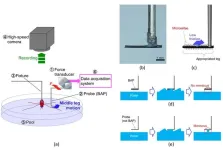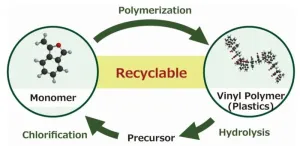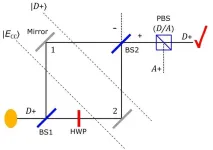(Press-News.org) ORLANDO, Fla. (Jan. 9, 2024) — Injecting neuroblastoma tumors with Zika virus shrank or eliminated those tumors in studies with mice, suggesting that the virus could someday serve as an effective cancer therapy, according to a study led by Nemours Children’s Health researchers and published today in Cancer Research Communications, a journal of the American Association for Cancer Research.
Neuroblastoma is a rare childhood cancer that typically develops in the sympathetic nervous system or the adrenal glands. Only 700 to 800 cases are diagnosed each year in the United States, accounting for 6% of childhood cancer diagnoses. However, high-risk neuroblastoma takes a disproportionate toll, causing 15% of childhood cancer deaths.
“More than half of patients with high-risk neuroblastoma do not respond to chemotherapy or radiation, or they respond initially, but develop a recurrence,” explained the study’s senior author, pediatric surgeon Tamarah Westmoreland, MD, PhD, Associate Professor of Surgery at Nemours Children’s in Orlando. “These patients are in urgent need of new treatment options.”
In recent years, researchers have discovered that Zika virus, which is carried by mosquitoes, can potentially be used to kill cancer cells. Zika virus infections in pregnant women can cause serious birth defects as the virus targets CD24, a developmental protein. Previous research has suggested that certain cancers that express the CD24 protein are also vulnerable to the Zika virus, opening the door for Zika virus to be used as a treatment. In this study, Westmoreland and first author Joseph Mazar, PhD, Research Scientist at Nemours Children’s, examined Zika’s potential against neuroblastoma.
The researchers studied mice with neuroblastoma tumors that express high levels of CD24. They injected half of the mice with a saline solution, and the other half with Zika virus. Tumor sizes were monitored three times a week thereafter.
The study showed that all mice injected with the Zika virus experienced a nearly total loss of tumor size. The highest dosage tested resulted in complete elimination of the tumor, which was confirmed by an independent Nemours Children’s pathologist. In four weeks of follow-up, there was no recurrence of the tumor. Furthermore, the mice did not develop any symptoms of Zika virus infection or any side effects.
To determine whether treatment with Zika virus is likely to help human patients survive longer, the researchers developed mouse models of human neuroblastoma tumors, treating them with either Zika virus or a saline solution. Twenty-eight days after the treatment, all tumors that received the saline solution had grown by as much as 800%. The tumor models that had received Zika had shrunk to approximately 12% of the original mass, which was confirmed to represent scar tissue rather than the tumor cells. After four additional weeks, no further tumor growth was detected, suggesting that patients treated with Zika virus would be more likely to survive.
The researchers cautioned that the use of Zika virus as a cancer therapy will require extensive additional studies encompassing safety and efficacy. They are currently testing Zika virus treatment in mouse adrenal glands growing neuroblastoma, mimicking neuroblastoma’s most typical location in humans. Routine use in the United States would require testing in clinical trials and ultimately approval by the U.S. Food and Drug Administration.
“With further validation, Zika virus could be an extremely effective bridge therapy for patients with high-risk neuroblastoma,” said Mazar. “We also see potential for Zika virus to be used to treat children and adults with other cancers that express high levels of CD24.”
“Neuroblastoma is often a very challenging diagnosis, especially for the patients who are unlikely to respond well to chemotherapy,” said Matthew M. Davis, MD, MAPP, Executive Vice-President, Enterprise Physician-in-Chief and Chief Scientific Officer of Nemours. “Dr. Westmoreland and Dr. Mazar are at the forefront of potentially lifesaving cancer treatment. We are hopeful that this study will pave the way toward improved survival for patients with neuroblastoma.”
Zika background
Zika virus was first identified in monkeys in Uganda in 1947, and first identified in humans in 1952. Spread by the bite of an infected mosquito, Zika virus can be passed from a pregnant woman to her fetus as the virus targets CD24, a developmental protein. Infection during pregnancy can lead to birth defects, including a small head size and an underdeveloped brain.
While Zika virus infection is most common in tropical regions, the United States experienced a rise in cases in 2016 and 2017, primarily in Florida and Texas.
In most humans, Zika virus infection results in mild cold-like symptoms. Most people infected with the virus never develop symptoms.
This study builds upon a 2018 study by Westmoreland, Mazar, and Kenneth Alexander, MD, PhD, Chief of the Division of Infectious Diseases at Nemours Children’s Health in Orlando. That research established the precedent that Zika virus could kill neuroblastoma cells.
Zika virus has also been studied as a potential treatment for glioblastoma, a deadly brain cancer.
About Nemours Children’s Health
Nemours Children’s Health is one of the nation’s largest multistate pediatric health systems, which includes two free-standing children's hospitals and a network of more than 70 primary and specialty care practices. Nemours Children's seeks to transform the health of children by adopting a holistic health model that utilizes innovative, safe and high-quality care, while also caring for the health of the whole child beyond medicine. Nemours Children's also powers the world’s most-visited website for information on the health of children and teens, Nemours KidsHealth.org.
The Nemours Foundation, established through the legacy and philanthropy of Alfred I. duPont, provides pediatric clinical care, research, education, advocacy, and prevention programs to the children, families and communities it serves. For more information, visit Nemours.org.
END
Nemours Children’s Health researchers find Zika virus is effective when used to treat a type of childhood cancer in mice
In models of neuroblastoma, Zika injection dramatically improved survival
2024-01-09
ELSE PRESS RELEASES FROM THIS DATE:
Multidisciplinary panel advocates for increased adoption of Intravascular Ultrasound (IVUS) in peripheral vascular interventions
2024-01-09
EMBARGOED UNTIL 10:00 AM ET ON JANUARY 9, 2024
WASHINGTON (January 9, 2024) – Proceedings from an expert consensus roundtable that discussed the benefits of intravascular ultrasound (IVUS) in lower extremity revascularization procedures were released today in the Journal of the Society for Cardiovascular Angiography & Interventions (JSCAI), Journal of Vascular and Interventional Radiology (JVIR), and Journal of Vascular Surgery - Vascular Insights.
The roundtable focused on the current challenges in diagnosing ...
Analysis of rowing force of the water strider middle leg by direct measurement using a bio-appropriating probe and by indirect measurement using image analysis
2024-01-09
A research paper by scientists at the Ibaraki University analyzed the rowing force of the water strider middle leg by direct measurement using a bio-appropriating probe and by indirect measurement using image analysis.
The new research paper, published on Nov. 17 in the journal Cyborg and Bionic Systems, reported the rowing force of water striders obtained by direct and indirect measurements, and analyzed the maximum force arrival time and the middle leg angular velocity of the direct and indirect force measurements.
“Rowing force of the middle leg of a water ...
Discovering a new mechanism of vestibular neuritis
2024-01-09
Prof. Sun-Uk Lee of the Department of Neurology and Prof. Euyhyun Park of the Department of Otorhinolaryngology from Korea University’s Anam Hospital discovered a new mechanism of vestibular neuritis.
Vestibular neuritis is one of the common diseases causing acute dizziness. It is known to be caused by an inflammation in the vestibular nerve and inner ear, which is responsible for balance and body motion sensation.
Various mechanisms had been suggesting as the cause of vestibular neuritis, such as reactivation of latent herpes virus or peripheral blood circulation disorder in the ...
Researchers developing AI to make the internet more accessible
2024-01-09
COLUMBUS, Ohio – In an effort to make the internet more accessible for people with disabilities, researchers at The Ohio State University have begun developing an artificial intelligence agent that could complete complex tasks on any website using simple language commands.
In the three decades since it was first released into the public domain, the world wide web has become an incredibly intricate, dynamic system. Yet because internet function is now so integral to society’s well-being, its complexity also makes it considerably harder to navigate.
Today there ...
Scientists outline a bold solution to climate change, biodiversity loss, social injustice
2024-01-09
CORVALLIS, Ore. – An international team of scientists led by Oregon State University researchers has used a novel 500-year dataset to frame a “restorative” pathway through which humanity can avoid the worst ecological and social outcomes of climate change.
In addition to charting a possible new course for society, the researchers say their “paradigm shifting” plan can support climate modeling and discussion by providing a set of actions that strongly emphasize social and economic justice as well ...
Novel chemical recycling system for vinyl polymers of cyclic styrene derivatives
2024-01-09
Chemical recycling of widely used vinyl polymers (VPs) is one of the key technologies required for realizing a sustainable society. In this regard, a team of researchers from Shinshu University have recently reported a new chemical process that facilitates the depolymerization of cyclic styrene-based VPs, resulting in the recovery of a monomer precursor. This highly efficient chemical recycling system can help with effective resource circulation and the development of new plastic recycling technologies.
Vinyl polymers (VPs) are ...
Quantum particles can’t separate from their properties, after all
2024-01-09
The quantum Cheshire cat effect draws its name from the fictional Cheshire Cat in the Alice in Wonderland story. That cat was able to disappear, leaving only its grin behind. Similarly, in a 2013 paper, researchers claimed quantum particles are able to separate from their properties, with the properties travelling along paths the particle cannot. They named this the quantum Cheshire cat effect. Researchers since have claimed to extend this further, swapping disembodied properties between particles, disembodying multiple properties simultaneously, ...
Press passes now available for Discover BMB to be held March 23–26
2024-01-09
Complimentary press passes are now available for Discover BMB, the annual meeting of the American Society for Biochemistry and Molecular Biology (ASBMB). Join us March 23–26 in San Antonio to experience an engaging agenda showcasing the newest developments and current trends in the field.
As the flagship meeting for one of the largest molecular life science organizations in the world, #DiscoverBMB brings together researchers in academia and industry from across the globe.
Explore captivating science stories and connect with leading experts during the scientific symposia, which will encompass 12 themes. Topics include:
Exciting ...
New CRISPR Center brings hope for rare and deadly genetic diseases
2024-01-09
Children and adults with rare, deadly genetic diseases have fresh hope for curative therapies, thanks to a new collaboration between the Innovative Genomics Institute (IGI) and Danaher Corporation, a global life sciences and diagnostics innovator.
The new Danaher-IGI Beacon for CRISPR Cures center will use genome editing to address potentially hundreds of diseases, including rare genetic disorders that have no cure. The goal is to ensure treatments can be developed and brought to patients ...
Three researchers awarded $1 million each to study new heart disease treatments, causes
2024-01-09
DALLAS, Jan. 9, 2024 — A physician-scientist from Massachusetts researching whether chemicals naturally occurring in foods could help treat heart disease, a genetics expert from Pennsylvania exploring the molecular mechanisms of lipid metabolism and cardiovascular diseases and a California-based professor of cardiovascular medicine studying how vaping impacts the development of abdominal aortic aneurysms are the most recent American Heart Association Merit Award recipients. Over the next five years, each researcher will receive a total of $1 million in funding from the Association, the world’s leading voluntary organization focused on heart and brain health and research, ...
LAST 30 PRESS RELEASES:
Insilico Medicine and Taigen achieves license agreement to develop and commercialize AI-driven PHD inhibitor for anemia of Chronic Kidney Disease (CKD)
Exploring dominant endophytic Pleosporales in grasses: New taxonomic insights in the suborder Massarineae
Comparative transcriptomic analysis of human maxillary and mandibular tooth germs reveals discrepancies in gene expression patterns
Scientists detect atmosphere on molten rocky exoplanet - study
Chip-scale magnetometer uses light for high-precision magnetic sensing
Illinois Tech biomedical engineering professor Philip R. Troyk elected as Fellow of the National Academy of Inventors
The National Academy of Inventors welcomes 2025 Class of Fellows
Multi-scale modelling framework predicts mechanical responses of Fe–Cr–Al alloys across composition and processing conditions
Preoperative radiation may improve antitumor immune response in most common form of breast cancer
Breast MRI may be safely omitted from diagnostic workup in certain patients with early-stage, HR-negative breast cancer
Sentinel lymph node biopsy may be safely omitted in some patients with early-stage breast cancer
Rats may seek cannabis to cope with stress
New FAU research strengthens evidence linking alcohol use to cancer
Gut health à la CAR T
Dr. Pengfei Liu receives 2026 O'Donnell Award in Medicine for pioneering advances in genetic diagnostics and rare disease treatment
Dr. Yunsun Nam receives 2026 O'Donnell Award in Biological Sciences for pioneering RNA research transforming gene regulation and cancer therapy
Dr. Bilal Akin wins 2026 O'Donnell Award in Engineering for transformative work in EV energy systems and industrial automation
Dr. Fan Zhang receives 2026 O'Donnell Award in Physical Sciences for groundbreaking discoveries in quantum matter and topological physics
Dr. Yue Hu receives 2026 O'Donnell Award for revolutionizing energy operations with real-time AI and reinforcement learning
Greater risk that the political right falls for conspiracy theories
JMC Publication: Insilico’s AI platforms enable discovery of potent, selective, oral DGKα inhibitor to overcome checkpoint resistance
Targeting collagen signaling boosts drug delivery in pancreatic cancer
Valvular heart disease is common in cancer patients but interventions improve survival
When socially responsible investing backfires
Cuffless blood pressure technologies in wearable devices show promise to transform care
AI-based tool predicts future cardiovascular events in patients with angina
Researchers map how the cerebellum builds its connections with the rest of the brain during early development
Routine scans could detect early prostate radiotherapy changes
Fairness in AI: Study shows central role of human decision-making
Pandemic ‘beneath the surface’ has been quietly wiping out sea urchins around the world
[Press-News.org] Nemours Children’s Health researchers find Zika virus is effective when used to treat a type of childhood cancer in miceIn models of neuroblastoma, Zika injection dramatically improved survival



